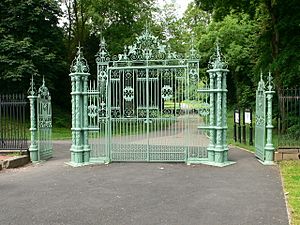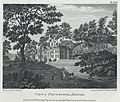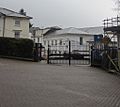Pontypool Park facts for kids
Quick facts for kids Pontypool Park |
|
|---|---|

The Pontymoile Gates - a gift from Sarah Churchill, Duchess of Marlborough
|
|
| Type | School |
| Location | Pontypool, Torfaen |
| Built | Early 18th century |
|
Listed Building – Grade II
|
|
| Official name: St. Alban's R.C. School | |
| Designated | 2 July 1962 |
| Reference no. | 3119 |
|
Listed Building – Grade II*
|
|
| Official name: The Valley Inheritance Museum | |
| Designated | 2 July 1962 |
| Reference no. | 3120 |
|
Listed Building – Grade II
|
|
| Official name: Double icehouse in Pontypool Park | |
| Designated | 28 August 1997 |
| Reference no. | 18811 |
|
Listed Building – Grade II*
|
|
| Official name: Shell Grotto | |
| Designated | 2 July 1962 |
| Reference no. | 3122 |
|
Listed Building – Grade II*
|
|
| Official name: Entrance Gates to Pontypool Park. | |
| Designated | 29 May 1997 |
| Reference no. | 18466 |
| Lua error in Module:Location_map at line 420: attempt to index field 'wikibase' (a nil value). | |
Pontypool Park (Welsh: Parc Pont-y-pŵl) is a huge park in Pontypool, Torfaen, Wales. It covers about 150 acres (0.6 square kilometers)! This park used to be the private grounds of a big house called Pontypool House. It was first designed in the late 1600s for John Hanbury. He was an ironmaster, meaning he owned and managed iron factories. He was also known for his special "Japanware" products.
In 1920, the local council bought the park grounds. The main house was rented out, and later sold, to a group of nuns. They turned it into St. Alban's RC High School. The old stables of the house now hold the Torfaen Museum. Inside the park, you can find many interesting old buildings. These include a double ice house, the Folly Tower, and the Shell Grotto. You enter the park through the impressive Pontymoile Gates. Many of these buildings are protected as important historic sites.
Contents
History of Pontypool Park
How the Park Began
John Hanbury (1664–1734) was a very successful businessman. He made his family's ironworks in Pontypool a big success. He also started creating the Pontypool Park estate. Sadly, none of his original 17th-century house remains today.
John Hanbury's second wife, Bridget Ayscough, was good friends with Sarah Churchill, Duchess of Marlborough. This friendship was important! It led to Hanbury being chosen to help manage the will of John Churchill. The beautiful Pontymoile Gates at the park entrance were a gift from Sarah Churchill. They used to stand between Hanbury's house and the stables. Around 1835, they were moved to where they are now. These gates are also a protected historic structure.
Developing the Estate
The main house you see at Pontypool Park today was built by John Hanbury (1744–1784). He continued to improve both the family business and the park. Around 1762, he built the Folly Tower. This tower was an "eyecatcher," meaning it was built to look nice and add to the landscape.
His third son, Capel Hanbury, who later added "Leigh" to his name, also worked to make the estate even better. A historian named Archdeacon Coxe visited the park in 1799-1800. He wrote about seeing the tower with Hanbury-Leigh. He said the view from the tower was amazing, combining wild and fertile parts of Monmouthshire.
In the 1830s, Hanbury Leigh made the house much bigger, doubling its size. He also built new stables and the unique Shell Grotto in the park. The stables now house the Torfaen Museum. They are also protected as important historic buildings.
Pontypool Park Today
In the 1920s, the Hanbury Leigh family decided to end their connection with Pontypool Park. They gave the house to the Roman Catholic Church. They sold the gardens and park to the local council. The house is still a school today. The park is looked after by Torfaen County Borough Council for everyone to enjoy.
Exploring Pontypool Park
Where is the Park?
Pontypool Park is a large area located to the east of Pontypool town centre. The main part of the park begins near the Pontymoile Gates. These gates are close to New Inn and Pontymoile Basin. The park stretches north towards St Alban's RC High School and the Torfaen Museum.
To the east, the land goes uphill towards the Folly Tower and the Shell Grotto. The western side of the park follows the Afon Lwyd river. The Pontypool Leisure Centre is also on this side. You can find the beautiful Italian Gardens close to the western edge.
The park also has the Nant-y-Gollen Ponds. These were once a large millpond that powered a forge. Three main paths cross the park. They all meet near the leisure centre in the middle of the park.
What Can You See and Do?
The park has lots of open grassy areas and mixed woodlands. You'll see many old sweet chestnut trees. One of the oldest is a 400-year-old hollow tree. It was even voted the "Welsh Tree of the Year" in 2019!
In 1923, a Gorsedd stone circle was built in the park. This was for the 1924 National Eisteddfod of Wales, a big Welsh cultural festival. There's also a double ice house near the old Pontypool House and Pontypool Museum. This building is also protected as a historic site.
Pontypool's main leisure centre is right inside the park. A dry ski slope was built here in 1975 and is still used today. The park also has outdoor tennis courts, netball courts, and a bowling green. The Pontypool RFC rugby team plays at their stadium in the park. The stadium can hold 8,800 people! There's also a bandstand. It's used for the yearly Jazz in the Park festival.
The Folly Tower
The Folly Tower is a three-story tower. It stands near the eastern edge of the park. John Hanbury (1744–1784) first built it in 1762. During the Second World War, the original tower was taken down. People worried it might help German planes find their way. The tower you see today is a copy, built in 1994.
The Shell Grotto
A short walk from the Folly Tower is the amazing Shell Grotto. It was designed by S. Gunston Tit. Capel Hanbury Leigh asked for it to be built in the 1830s. A garden historian called Elisabeth Whittle said the grotto is a "magnificent survivor." The inside of the grotto is decorated with shells and bones. People say Capel Hanbury Leigh's first wife, Molly Mackworth, did this work. Both the Folly Tower and the Shell Grotto are open to visitors on weekends from May to September. The grotto was restored in the 1990s. It is also a protected historic building.
Gallery





